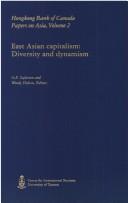| Listing 1 - 2 of 2 |
Sort by
|
Book
ISBN: 9780804727198 Year: 1996 Publisher: Stanford (Calif.) : Stanford University Press,
Abstract | Keywords | Export | Availability | Bookmark
 Loading...
Loading...Choose an application
- Reference Manager
- EndNote
- RefWorks (Direct export to RefWorks)
The last twenty years have seen a growth of fascinating with the Japanese, and the emergence of Japan as a world economic power has stimulated many works that have attempted to understand Japanese culture. The focus of this book is not on Japanese culture or society per se: rather, it is on how Japanese culture and society structure, shape, and mold the emotions of the Japanese people. All cultures shape and mold emotions, but the degree to which Japanese culture shapes emotion has led to several misunderstandings about the emotional life of the Japanese, which this book attempts to correct. Describing the findings of over two decades of research, this book presents the Japanese as human beings with real feelings and emotions rather than as mindless pawns caught in the web of their own culture. In the process, it unmasks many myths that have grown up around the subject and reveals important similarities as well as differences between the emotional life of the Japanese and that of people of other cultures.
73.85 cultural psychology. --- Caractère national japonais. --- Emoties. --- Emotions --- Emotions. --- Gefühl. --- Japaner. --- Japanese --- Japanners. --- Japonais --- Japonais. --- National characteristics, Japanese. --- Nationalcharakter. --- Psicologia --- Émotions --- Psychology. --- Psychologie. --- Études transculturelles. --- Etudes transculturelles.

ISBN: 1442674229 1282025686 9786612025686 9781442674226 0802042015 0802080588 Year: 1996 Publisher: Toronto : University of Toronto Press,
Abstract | Keywords | Export | Availability | Bookmark
 Loading...
Loading...Choose an application
- Reference Manager
- EndNote
- RefWorks (Direct export to RefWorks)
What price will North American business pay if it fails to develop an understanding of the role of East Asia in the transformation of global competition? Competition in this region has been intensifying as the pace of technological change speeds up and new competitors appear. Canada has major opportunities in its economic relation-ships with the rapidly emerging dynamic East Asian economies. But the diversity and dynamism of East Asia's capitalism must be understood by those who wish to meet their competitors there successfully. Understanding how and why businesses are organised the way they are, and how they are changing, will help considerably in penetrating East Asian markets. Asian business systems should be understood for their remarkable diversity, across economies as well as within economies. The essays in this book explain the origins and prospects of East Asia's major business players - the Japanese keiretsu, Korean chaebol, China's emerging industry structure and business groups, and family networks in Southeast Asia and Taiwan. Most Asian businesses emphasize cooperative business relations, based most often on family and other informal ties, and cooperation with the state. To identify future business partners, Canadian firms must understand the strategies of other firms and governments: the linkages between trade and investment; and innovative business systems and how to work with them. The purpose of the Hongkong Bank of Canada Papers on Asia series is to provide practical information, in the form of timely and readable works, to Canadian business and government decision makers that will help increase knowledge and familiarity with the distant markets of East Asia. This series establishes benchmarks against which Canada's future can be measured systematically. Volume I, Benchmarking the Canadian Business Presence in East Asia explained Canada's relatively modest business presence in the region and outlined the high costs of entering into these dynamic markets. East Asian Capitalism: Diversity and Dynamism examines these systems as one aspect of reducing such entry costs. This volume is the first comparative analysis of Asian business systems published in Canada.
Industrial organization --- Capitalism --- Market economy --- Economics --- Profit --- Capital --- Industries --- Organization --- Industrial concentration --- Industrial management --- Industrial sociology --- Japan --- China --- Taiwan --- Südkorea --- Südostasien --- East Asia. --- Empire du Japon --- Nihon-koku --- Zen-Nihon --- Zenkoku --- Nippon --- Japon --- Dainihon --- Dainippon --- Nihon --- Yapan --- Japão --- Japaner --- Tai wan --- Zhong hua min guo --- Republik China --- Republic of China --- Nationalchina --- Zhonghua-Minguo --- Zhonghua --- Republik Zhongguo --- Chung-hua-min-kuo --- Chung-kuo --- ROC --- Republik Taiwan --- Formosa --- Republik Formosa --- Zhongguo --- Zhonghua minguo --- Nationalist China --- Zhonghua Minguo --- Chung-hua min kuo --- Tʻai-wan --- 台灣 --- 中華民國 --- 臺灣 --- Insel --- Taiwanesen --- Provinz Taiwan --- 1949 --- -East --- Eastern Asia --- Far East --- Asia --- Asien --- Südostasiaten --- Pazifischer Raum --- Ferner Osten --- Asiatisch-Pazifischer Raum --- Korea --- Dae han min gug --- Republik Korea --- Taehan-Min'guk --- Daehan-Min'guk --- Han'guk --- Han-kook --- Republic of Korea --- ROK --- Kankoku --- République de Corée --- South Korea --- República de Corea --- 한국 --- 韓國 --- 大韓民國 --- 대한민국 --- Südkoreaner --- Südkoreanerin --- 1945 --- -Rotchina --- Zhongguo-Diguo --- Kaiserreich Zhongguo --- Zhonghua-minguo --- Zhonghua-Renmin-Gongheguo --- Kaiserreich China --- PRC --- Shinkoku --- Chung-hua-jen-min-kung-ho-kuo --- Volksrepublik China --- VR China --- People's Republic of China --- Zhong guo --- Zhonghua renmin gongheguo --- République populaire de Chine --- Chung-kuo kuo min cheng fu --- Chine --- KNR --- Chinese People's Republic --- Kytajsʹkaja Narodnaja Respublika --- Chinese People’s Republic --- 中华人民共和国 --- Chinesen --- East --- -Tai wan --- Südkorea. --- Südostasien.
| Listing 1 - 2 of 2 |
Sort by
|

 Search
Search Feedback
Feedback About UniCat
About UniCat  Help
Help News
News